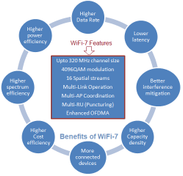WiFi-7 Channel to Center Frequency Conversion Calculator (802.11be)
Advertisement
This page explains how to convert WiFi-7 channel numbers to their corresponding center frequencies, as defined by the IEEE 802.11be standard. We’ll cover the formulas and provide a handy calculator for quick conversions.
This WiFi-7 channel frequency calculator converts channel number to center frequency based on bandwidth and channel number as inputs.
Introduction to WiFi-7 (802.11be)
IEEE 802.11be EHT (Extremely High Throughput) is designed for demanding applications requiring high throughput and low latency, such as:
- VR (Virtual Reality)
- AR (Augmented Reality)
- Gaming
- Cloud computing
It operates in the 2.4 GHz, 5 GHz, and 6 GHz frequency bands and supports bandwidths of 20 MHz, 40 MHz, 80 MHz, 160 MHz, and even 320 MHz. Key features include:
- 4096 QAM
- MLO (Multi-Link Operation)
- 16 x 16 MIMO
- OFDMA multi-RU allocation to single STA
- Preamble puncturing
Important Notes:
- IEEE 802.11be APs must support 160 MHz bandwidth in the 6 GHz band, 80 MHz in the 5 GHz band, and 20 MHz in the 2.4 GHz band.
- Non-AP STAs must support 80 MHz channel width in 5/6 GHz. 20 MHz STAs can operate in the 2.4 GHz and 5 GHz bands.
WiFi-7 Channel Numbers and Center Frequencies (5 GHz / 6 GHz)
Channel numbers for various bandwidths (20, 40, 80, 160, or 320 MHz) in the 5 GHz and 6 GHz bands are shown in Table 1.
Table 1: Channel Numbers for Different Bandwidths (5 GHz / 6 GHz)
| Channel Bandwidth (BW) (MHz) | Channel Numbers (U-NII-5, U-NII-6, U-NII-7, U-NII-8) |
|---|---|
| 20 MHz | [1, 5, 9, 13, 17, 21, 25, 29, 33, 37, 41, 45, 53, 57, 61, 65, 69, 73, 77, 81, 85, 89, 93, 97, 101, 105, 109, 113, 117, 121, 125, 129, 133, 137, 141, 145, 149, 153, 157, 161, 165, 169, 173, 177, 181, 185, 189, 193, 197, 201, 205, 209, 213, 217, 221, 225, 229, 233] |
| 40 MHz | [3, 11, 19, 27, 35, 43, 51, 59, 67, 75, 83, 91, 99, 107, 115, 123, 131, 139, 147, 155, 163, 171, 179, 187, 195, 203, 211, 219, 227] |
| 80 MHz | [7, 23, 39, 55, 71, 87, 103, 119, 135, 151, 167, 183, 199, 215] |
| 160 MHz | [15, 47, 79, 111, 143, 175, 207] |
| 320 MHz | [31, 63, 95, 127, 159, 191] |
WLAN Calculator - 1 for 5 GHz/6 GHz Bands
NOTE: Enter one Bandwidth value from range [20, 40, 80, 160, 320]
EXAMPLE #1:
- INPUTS: BW = 320 MHz, Channel Number = 31
- OUTPUT: WiFi 7 (802.11be) center frequency = 6105 MHz
WiFi-7 Channel Center Frequency Formula (IEEE 802.11be)
The following formulas are used to calculate the center frequency:
- Formula-1 (5/6 GHz bands): Refer to the image below for the specific formula.
- Formula-2 (2.4 GHz band): See the 2.4 GHz section below.

WiFi 7 Channel Assignments and Center Frequencies
The tables below show the channel numbers and their corresponding center frequencies for different bandwidths:
-
20 MHz Bandwidth:

-
40 MHz Bandwidth:

-
80 MHz Bandwidth:

-
160 MHz Bandwidth:

-
320 MHz Bandwidth:

WLAN Calculator #2 for 2.4 GHz Band
Table 2 shows channel numbers for 20 MHz bandwidth in the 2.4 GHz WiFi band.
Table 2: WLAN 2.4 GHz Bandwidth Channel Numbers
| Bandwidth | Channel Numbers |
|---|---|
| 20 MHz | [1, 2, 3, 4, 5, 6, 7, 8, 9, 10, 11, 12, 13, 14] |
EXAMPLE #2:
- INPUTS: WiFi 2.4 GHz Channel Number = 10 (Legacy wifi devices)
- OUTPUT: WiFi 2.4 GHz center frequency = 2457 MHz
Don’t forget to check out the WiFi7 802.11be data rate throughput calculator for more information.
References
- IEEE 802.11be TM Draft 1.1 Standard
Advertisement
 RF
RF

